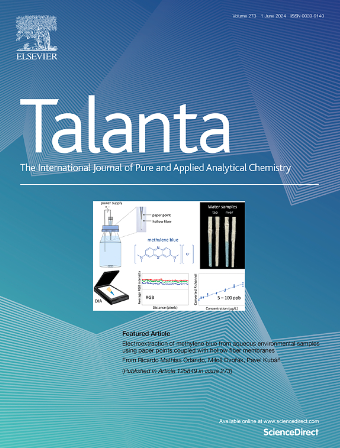Self-referenced ratiometric electrochemical biosensor based on covalent organic framework assembled MXene for stain-resistance and sensitive sensing of dopamine
IF 5.6
1区 化学
Q1 CHEMISTRY, ANALYTICAL
引用次数: 0
Abstract
Dopamine (DA) is not only an important neurotransmitter involving in the regulation of life activities, but also a typical biomarker of neurodegenerative diseases. Accurate detection of DA content is of great significance for early diagnosis and treatment of related illness. Herein, a ratio electrochemical sensing platform was constructed based on covalent organic framework (COF) assembled MXene composite nanomaterials for sensitive, selective and accurate detection of DA. β-ketoenamine COF with high electrochemical activity can export a stable electrochemical signal during the sensing process, which provides the necessary conditions for the construction of ratio electrochemical biosensor. MXene, an emerging material with rich functional groups, as a carrier for in-situ growth of COF, effectively improves the material conductivity, and significantly amplifies the reference signal of COF and response signal of DA, simultaneously. It is the hydrogen bonds and van der Waals force between COF and the target molecule that achieve the selective response of the modified material to DA. Due to the synergistic effect between COF and MXene, the sensing platform (TFAQ COF@MXene/GCE) exhibited an excellent analytical performance towards DA with a wide linear range (0.05–800 μM) and low detection limit (0.0061 μM) as well as good stain-resistance and reproducibility and achieved precise analysis of DA in drug injection and human serum. This work provides a new and effective strategy for constructing COFs-based electrochemical sensors with self-calibration, strain-resistance and significant signal amplification.

基于共价有机骨架组装MXene的自参比电化学生物传感器,用于抗染色和敏感感知多巴胺
多巴胺(Dopamine, DA)是一种重要的参与生命活动调控的神经递质,也是神经退行性疾病的典型生物标志物。准确检测DA含量对相关疾病的早期诊断和治疗具有重要意义。本文以共价有机骨架(COF)组装MXene复合纳米材料为基础,构建了一种灵敏、选择性、准确检测DA的比例电化学传感平台。具有较高电化学活性的β-酮胺COF能在传感过程中输出稳定的电化学信号,为构建比例电化学生物传感器提供了必要条件。MXene是一种具有丰富官能团的新兴材料,作为原位生长COF的载体,有效提高了材料的电导率,同时显著放大了COF的参考信号和DA的响应信号。COF与靶分子之间的氢键和范德华力实现了改性材料对DA的选择性响应。由于COF和MXene之间的协同作用,该传感平台(TFAQ COF@MXene/GCE)对DA具有良好的分析性能,线性范围宽(0.05 ~ 800 μM),检出限低(0.0061 μM),具有良好的耐染性和重复性,可实现药物注射液和人血清中DA的精确分析。本研究为构建具有自校准、抗应变和显著信号放大的cofs电化学传感器提供了一种新的有效策略。
本文章由计算机程序翻译,如有差异,请以英文原文为准。
求助全文
约1分钟内获得全文
求助全文
来源期刊

Talanta
化学-分析化学
CiteScore
12.30
自引率
4.90%
发文量
861
审稿时长
29 days
期刊介绍:
Talanta provides a forum for the publication of original research papers, short communications, and critical reviews in all branches of pure and applied analytical chemistry. Papers are evaluated based on established guidelines, including the fundamental nature of the study, scientific novelty, substantial improvement or advantage over existing technology or methods, and demonstrated analytical applicability. Original research papers on fundamental studies, and on novel sensor and instrumentation developments, are encouraged. Novel or improved applications in areas such as clinical and biological chemistry, environmental analysis, geochemistry, materials science and engineering, and analytical platforms for omics development are welcome.
Analytical performance of methods should be determined, including interference and matrix effects, and methods should be validated by comparison with a standard method, or analysis of a certified reference material. Simple spiking recoveries may not be sufficient. The developed method should especially comprise information on selectivity, sensitivity, detection limits, accuracy, and reliability. However, applying official validation or robustness studies to a routine method or technique does not necessarily constitute novelty. Proper statistical treatment of the data should be provided. Relevant literature should be cited, including related publications by the authors, and authors should discuss how their proposed methodology compares with previously reported methods.
 求助内容:
求助内容: 应助结果提醒方式:
应助结果提醒方式:


